- Home >
- Short-tailed Albatross >
- Torishima –Operation Decoy
Short-tailed Albatross
Torishima –Operation Decoy
Update: June 16, 2017
In order to recover the endangered Short-tailed Albatross population, Yamashina Institute for Ornithology has been implementing the Operation Decoy in Torishima in the Izu island chain.
What is Operation Decoy?
Most of the world's population of the endangered Short-tailed Albatross breeds on Torishima in the Izu Island chain. The breeding colony is situated at Tsubamezaki, a sloped area located in the southeast of the island. Operation Decoy is an endeavor to attract the Short-tailed Albatross to Hatsunezaki, a gently sloped area located on the west side of the island, so that they can establish a new breeding colony there. In this project, many lifelike decoys of the Short-tailed Albatross are installed in Hatsunezaki together with playback calls, making it look as if there is a breeding colony and attracting albatrosses for breeding. The Short-tailed Albatross is a colonial breeder and is attracted by the sight and sounds of a large congregation of their conspecifics.
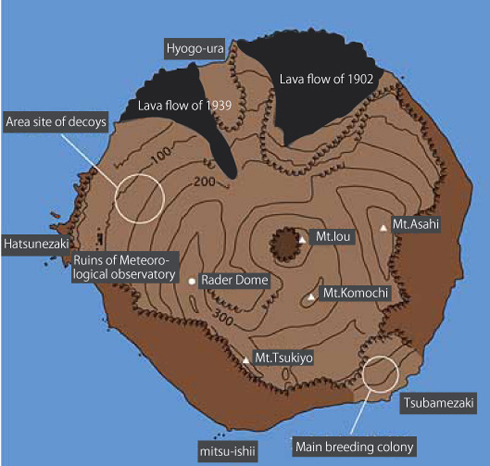
Map of Torishima
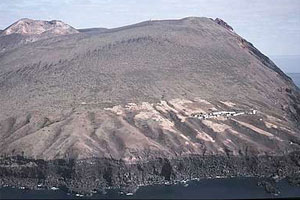
View of Hatsunezaki
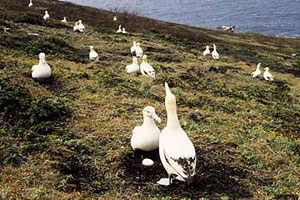
Decoys on Hatsunezaki
Objectives of Operation Decoy – Population recovery and risk reduction
The primary objective of the Operation Decoy is to attract the Short-tailed Albatross to a site that is favorable for breeding and to facilitate recovery of their population. Tsubamezaki, the conventional breeding site, is steep sloped with the volcanic deposits often sliding down the slope. Accidents frequently occur and eggs and chicks in the nests often get flushed or buried by the sliding sediments, making it difficult to maintain high breeding success. On the other hand, Hatsunezaki located on the other side of the island is gently sloped and is covered by grass with no sliding of surface sediments, and has a better environmental condition for breeding. If the Operation Decoy can successfully facilitate breeding in Hatsunezaki, frequency of breeding failure will be reduced and rapid population growth can be expected.
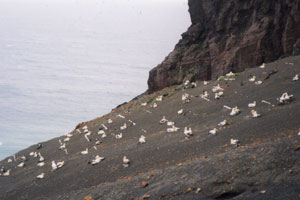
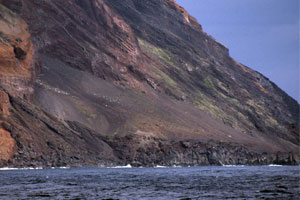
Steep slope of Tsubamezaki. White dots on a flat slope are Short-tailed Albatrosses
The second objective is risk reduction. The breeding site of Tsubamezaki was the world's only breeding site besides the Senkaku Islands where a small number of breeding population can be seen. Torishima is a volcanic island and may erupt any time. Depending on the way and timing of eruption, Torishima population may get decimated or extirpated. Creating a new breeding site in Hatsunezaki, although on the same island, is expected to reduce the risks due to possible eruption. The Short-tailed Albatross used to breed widely across the Torishima Island but they only survived in Tsubamezaki where the unfavorable environmental condition prevented human access for culling. They still remain in Tsubamezaki although there is no more risks of culling on the island. Such pensistent behavior of the Short-tailed Albatross probably protected them from extinction. With no more risk of mass killing by human for feather harvesting, facilitating breeding in the gentle slopes on the other side of the island should not be a problem.
Importance of attracting young birds
Attracting young birds is the key to the success of making Short-tailed Albatross breed in the new breeding site. Young birds return to Torishima for the first time at the ages of 2 to 5 and spend one to two breeding seasons looking for breeding sites and mates. Once a young bird finds a good site and a mate it begins breeding at that location the next breeding season. The Operation Decoy targets such young individuals looking for breeding sites. Attracting young individuals around the decoy is expected to promote forming of new pairs and nesting at the site.
This may sound rather tedious, but it is in fact an ingenious approach, taking advantages of the colonial breeding habit of seabirds. Adult birds that have already begun breeding at the conventional breeding site of Tsubamezaki will not move to a new site because of their habit of sticking to a single breeding site. Even if they are caught and transported to the new site they will soon return to Tsubamezaki. Transplanting chicks from Tsubamezaki to Hatsunezaki and making them fledge from there may result in them returning to Hatsunezaki as their nest site. However, this method still has technical issues that have to be solved before it can be put into practice.
What are decoy and sound playback?
Decoys of Short-tailed Albatross used in the Operation Decoy are made of fiber-reinforced plastic (FRP) and are painted to look lifelike. They are produced using mold created by a lifelike wooden carving. There are three types of decoys with representative breeding postures: standing, brooding and courtship display with neck stretched out. As for the colors there are two patterns; adult coloration with white head with golden tinge, and subadult coloration with brown head. There was 90 decoys installed on the slopes of Hatsunezaki (*) There are also several egg like figures installed besides the bird shaped decoys.
* The Operation Decoy was considered a success in the breeding season of 2005-2006 and it was decided to stop placing decoys starting the fall of 2006.

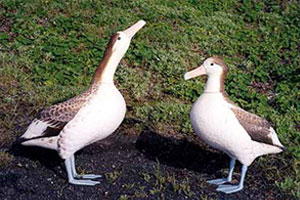
Patterns of the decoys
The calls of the Short-tailed Albatross are released from two lines of speakers, one with calls of courtship display and the other with lively sounds of a breeding colony. Torishima is an uninhabited island, thus there is no supply of electricity. Sounds recorded in an IC chip are played with electricity generated with a solar panel placed at the site.
Operation Decoy tries to reproduce a breeding colony of Short-tailed Albatross using these decoys and sound playback. Creating an atmosphere that makes a young albatross flying nearby to want to land will be a success of this project.
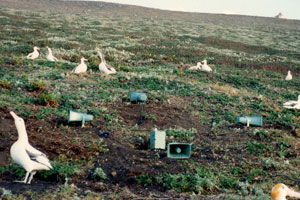
Installed speakers (surrounded by decoys)
A year of Operation Decoy
The Short-tailed Albatross return to Torishima in October. They lay and brood eggs, and raise chicks before leaving the island again in late April. The chicks also fledge and leave the island in mid to late May. There is no Short-tailed Albatrosses on Torishima in the summer when typhoon path.
Decoys and other apparatus for the Operation Decoy are put away in a building during the summer. This is to prevent damaging of the equipments by typhoons. They are once again installed in the fall before the Short-tailed Albatross return to the island in October. Researchers of the Institute visit the island in November for observing egg laying, and in February for observing albatrosses attracted to decoys. They once again visit in May when albatrosses leave the island to stow away the equipments.
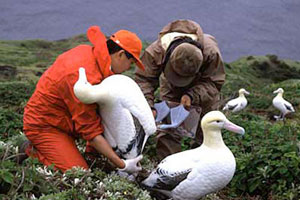
Installation of decoys
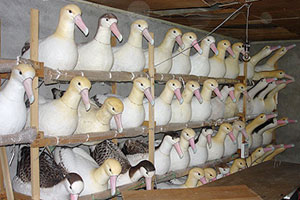
Stowed away decoys (Photo: Tanaka Fumio)
Backgrounds of Operation Decoy
The first case of bird conservation using decoys was by Stephen Kress of Cornell Lab of Ornithology in 1970's. They used decoys to restore breeding colony of a colonial seabird called the Atlantic Puffin Fratercula arctica in Maine, USA. Short-tailed Albatross researcher Hasegawa Hiroshi read about this case and introduced it at many occasions indicating a possibility of applying this method for the Short-tailed Albatross, and by 1990s it became known among Japanese bird conservationists. However, the momentum to actually transforming this idea into practice did not develop so soon, as such work would require more than 10 years in a remote uninhabited island of Torishima which is difficult to even make a visit.
However, things began to move when a bird carver Haruo Uchiyama heard Hasegawa's proposal on radio and carved a wooden prototype decoy of the Short-tailed Albatross. Bird carving is creation of bird sculptures made of wood and is popular in North America as interior decoration. Uchiyama Haruo is a pioneer and the leading bird carving artist in Japan. He voluntarily created a prototype decoy and brought it into the Yamashina Institute for Ornithology. He later said "I brought it into many organizations but they all rejected the idea. Lastly I visited the most financially deprived Yamashina Institute for Ornithology and to my surprise they accepted the prototype"
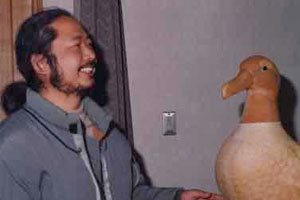
Uchiyama Haruo brought in the hand-made wooden decoy to the Yamashina Institute for Ornithology (December 1990)
Yamashina Institute for Ornithology tentatively produced six FRP decoys in 1991 funded by Suntory Fund for Birds Conservation and donations from the public, and conducted preliminary testing together with Hasegawa using the six decoys and sound playback in Tsubamezaki in Torsihima in November of that year. The result was highly promising, with a juvenile landing near the decoys only about one hour after installation. A second test was conducted in Hatsunezaki in April 1992 and good results were obtained again. Encouraged by these achievements, 41 decoys were installed by November of that year. With the growing number of decoys and a sound playback donated by Sanyo Electric Co.. From 1992 the Operation Decoy became a commissioned project by the Environmental Agency (currently Ministry of the Environment) to the Yamashina Institute for Ornithology. The project also receives funds and donations from companies, organizations and individuals.
Achievements so far
The first egg laying was confirmed in Hatsunezaki in the autumn of 1995 and a chick fledged in June 1996. Since then there have been seven chicks fledged from the same pair. A egg laying by another pair was also confirmed in autumn of 1996. In the breeding season of the autumn 2004 - 2005, four pairs laid eggs and all four chicks fledged. The number of breeding pairs increased dramatically in the autumn of 2005 and 16 pairs laid eggs, 13 chicks hatched in 2006 and as stated at the beginning, all of them successfully fledged.
| 1995-96 | 1 pair laid an egg, hatched, and fledged |
| 1996-97 | 2 pairs laid eggs |
| 1997-98 | 1 pair laid an egg, hatched, and fledged |
| 1998-99 | 1 pair laid an egg, hatched, and fledged |
| 1999-00 | 1 pair laid an egg, hatched, and fledged |
| 2000-01 | 1 pair laid an egg, hatched, and fledged, Return of a young bird born in spring 1998 |
| 2001-02 | 1 pair laid an egg, hatched, and fledged, Return of a young bird born in spring 1999 |
| 2002-03 | 1 pair laid an egg, hatched, and fledged, Return of a young bird born in spring 2000 |
| 2003-04 | 1 pair laid an egg, hatched, and fledged, 10 pairs built nests |
| 2004-05 | 4 pairs laid eggs, hatched and fledged A small colony established |
| 2005-06 | 16 pairs laid eggs, 13 hatched and fledged |
| 2006-07 | 24 pairs laid eggs, 16 hatched and fledged |
The purpose of the Operation Decoy is to establish a breeding colony with multiple number of breeding pairs. Attracting as many Short-tailed Albatrosses as possible and making them land on Hatsunezaki is necessary for the site to become a breeding colony. The research team considered that it was necessary to determine whether it was going well or not. The graph shown below indicates how many Short-tailed Albatrosses have landed in Hatsunezaki using an indicator "stay index".
Stay Index = (total landing time of all the individuals observed landed)÷(observation time)
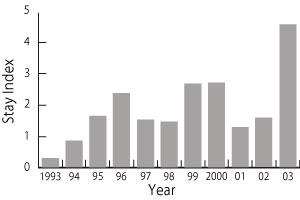
Stay Index in Hatsunezaki (February to March)
(Sato, et al., unpublished)
The stay index becomes larger as the number of landed individuals and the landing time increase. The graph above shows the stay indices calculated from the observation made during about 10 days in February to March every year.
According to the graph the index value increased from the spring 1995, before the first breeding season, and increased dramatically in the first breeding season of spring 1996. Many Short-tailed Albatrosses were in fact observed to have landed in Hatsunezaki. After that, there were some seasons when the stay index value was kept at low, but it increased again in spring 2003, indicating that many individuals were attracted to the decoy installed site.
To our delight, so many individuals landed at the new colony site from 2004 and it became impossible to record total landing time of all individuals necessary for calculation of stay index. Instead, number of individuals landed in Hatsunezaki at 17:00 counted every year in the February to March observation was plotted in the graph below.
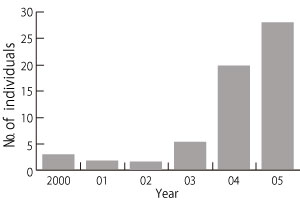
Individuals landed in Hatsunezaki at 17:00 (average number per day during February to March observation)
(Sato, et al., unpublished)
The graph shows that the number of landed individuals in the evening increased in spring 2004 when 10 pairs were observed building nests, and the number increased further in spring 2005.
Future prospects
16 pairs laid eggs and 13 chicks hatched and fledged in Hatsunezaki in the breeding season of 2005-6, making Operation Decoy a success after 15 years. This success has led to a decision that the decoys stowed in May 2006 will not be installed again in the autumn of that year. It is still required to continually monitor the breeding of the Short-tailed Albatross in Hatsunezaki to ensure that the number of breeding pairs will not be reduced. Furthermore, it is also considered that continued observation of Tsubamezaki, the conventional breeding site, will also be required.
The Yamashina Institute for Ornithology will continue careful observation of the Torishima while shifting the focus of our activities to formation of the third breeding colony besides the Torishima and Senkaku Islands.

